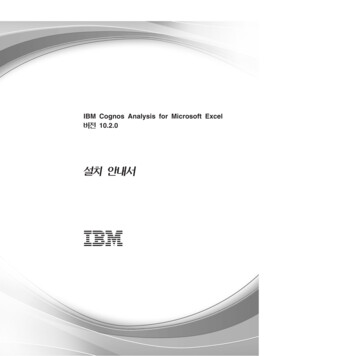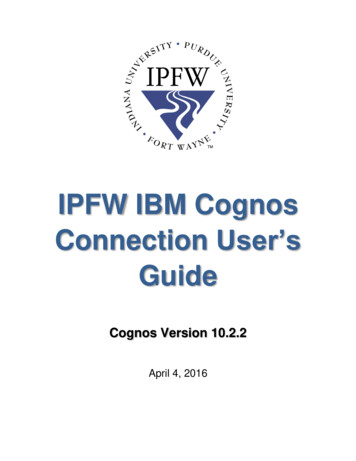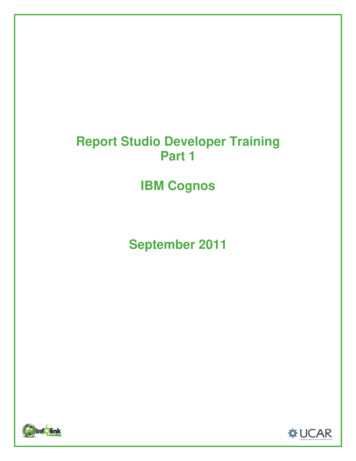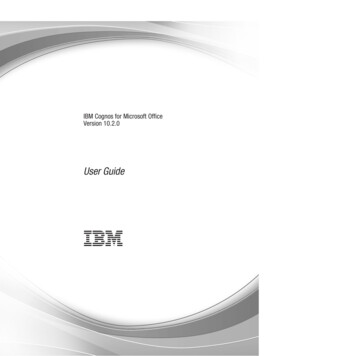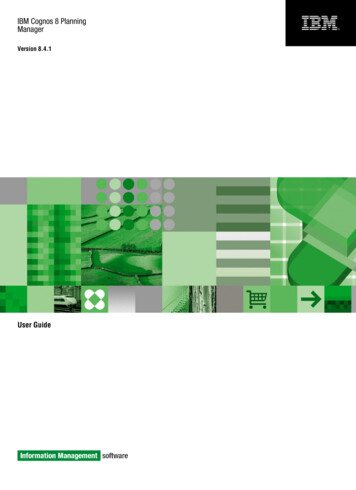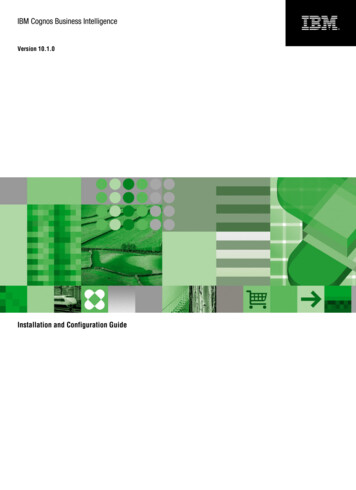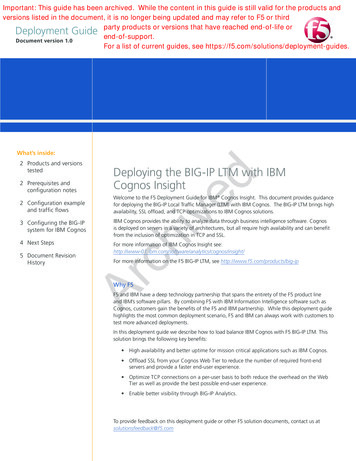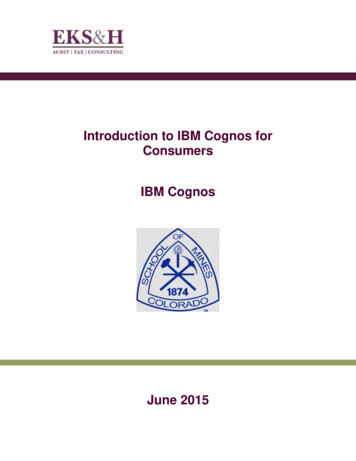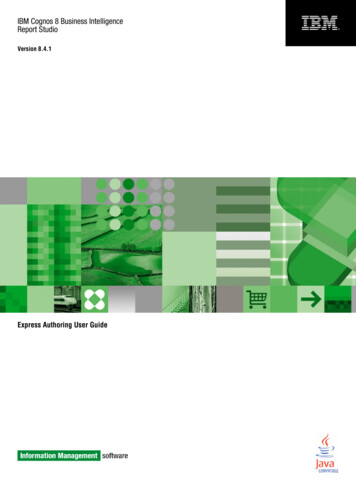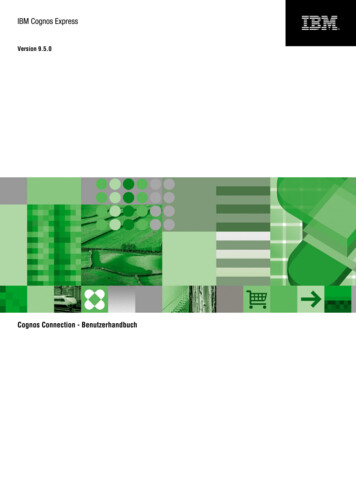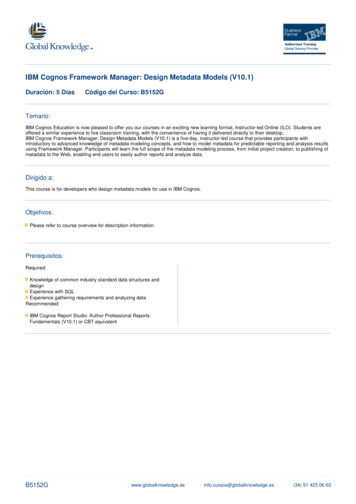
Transcription
IBM Cognos Framework Manager: Design Metadata Models (V10.1)Duración: 5 DíasCódigo del Curso: B5152GTemario:IBM Cognos Education is now pleased to offer you our courses in an exciting new learning format, Instructor-led Online (ILO). Students areoffered a similar experience to live classroom training, with the convenience of having it delivered directly to their desktop.IBM Cognos Framework Manager: Design Metadata Models (V10.1) is a five-day, instructor-led course that provides participants withintroductory to advanced knowledge of metadata modeling concepts, and how to model metadata for predictable reporting and analysis resultsusing Framework Manager. Participants will learn the full scope of the metadata modeling process, from initial project creation, to publishing ofmetadata to the Web, enabling end users to easily author reports and analyze data.Dirigido a:This course is for developers who design metadata models for use in IBM Cognos.Objetivos:Please refer to course overview for description information.Prerequisitos:Required:Knowledge of common industry standard data structures anddesignExperience with SQLExperience gathering requirements and analyzing dataRecommended:IBM Cognos Report Studio: Author Professional ReportsFundamentals (V10.1) or CBT globalknowledge.es(34) 91 425 06 60
Contenido:lineDiscuss IBM Cognos and PerformanceManagementExamine the characteristics of operationaldatabases and databases designed forreportingExamine key modeling recommendationsExamine the IBM Cognos BI and FrameworkManager workflow processesVerify relationships and query itempropertiesDescribe multi-fact queries and when fullouter joins are appropriateIdentify the advantages of modelingmetadata as a star schemaCreate virtual facts to simplify writing queriesUse calculations to createcommonly-needed query items for authorsMake time-based queries simple to authorby implementing a time dimensionUse determinants to specify multiple levelsof granularity and prevent double-countingIdentify the dimensions associated with afact tableIdentify key differences andrecommendations for using data source,model, and stored procedure query subjectsExamine the IBM Cognos BI securityenvironmentApply dimensional information to relationalMetadata to enable OLAP-style queriesDescribe model types and data entitiesIdentify conformed values between datasourcesGovernors that affect SQL generationIdentify session and model parametersPerform basic maintenance andmanagement on a modelIdentify and implement techniques tooptimize and tune your Framework ManagermodelsImplement repository controlConnect to an OLAP data source (cube) in aFramework Manager projectSpecify package languages and functionsetslineDescribe IBM Cognos componentsDescribe IBM Cognos architecture at a highlevelDefine IBM Cognos groups and rolesExplain how to extend IBM CognosIdentify Common Data StructuresExamine relationships and cardinalityIdentify different data trapsExamine OLAP data sourcesGather RequirementsDefine reporting requirementsExplore data sources to identify data accessstrategiesCreate a Baseline ProjectlineDescribe IBM Cognos componentsDescribe IBM Cognos architecture at ahigh levelDefine IBM Cognos groups and rolesExplain how to extend IBM CognosIdentify Common Data StructuresExamine relationships and cardinalityIdentify different data trapsExamine OLAP data sourcesGather RequirementsDefine reporting requirementsExplore data sources to identify dataaccess strategiesCreate a Baseline ProjectDefine a project and its structureDescribe the Framework ManagerenvironmentCreate a baseline projectEnhance the model with additionalmetadataPrepare Reusable MetadataEnsure efficient filters by configuringprompt propertiesModel for Predictable Results: IdentifyReporting IssuesDescribe how IBM Cognos BI usescardinalityIdentify reporting trapsUse tools to analyze the modelModel for Predictable Results: VirtualStar SchemasModel in layersCreate aliases to avoid ambiguous joinsMerge query subjects to create as viewbehaviorModel for Predictable Results:Consolidate MetadataCreate virtual dimensions to resolvefact-to-fact joinsCreate a consolidated modeling layer forpresentation purposesConsolidate snowflake dimensions withmodel query subjectsSimplify facts by hiding unnecessarycodesCalculations and FiltersUse static filters to reduce the datareturnedUse macros and parameters incalculations and filters to dynamicallycontrol the data returnedImplement a Time DimensionResolve confusion caused by multiplerelationships between a time dimensionand another tableSpecify DeterminantsCreate the Presentation ViewIdentify conformed vs. non-conformeddimensionsCreate star schema groupings to provideauthors with logical groupings of ibe IBM Cognos componentsDescribe IBM Cognos architecture at ahigh levelDefine IBM Cognos groups and rolesExplain how to extend IBM CognosIdentify Common Data StructuresExamine relationships and cardinalityIdentify different data trapsExamine OLAP data sourcesGather RequirementsDefine reporting requirementsExplore data sources to identify dataaccess strategiesCreate a Baseline ProjectDefine a project and its structureDescribe the Framework ManagerenvironmentCreate a baseline projectEnhance the model with additionalmetadataPrepare Reusable MetadataEnsure efficient filters by configuringprompt propertiesModel for Predictable Results: IdentifyReporting IssuesDescribe how IBM Cognos BI usescardinalityIdentify reporting trapsUse tools to analyze the modelModel for Predictable Results: Virtual StarSchemasModel in layersCreate aliases to avoid ambiguous joinsMerge query subjects to create as viewbehaviorModel for Predictable Results: ConsolidateMetadataCreate virtual dimensions to resolvefact-to-fact joinsCreate a consolidated modeling layer forpresentation purposesConsolidate snowflake dimensions withmodel query subjectsSimplify facts by hiding unnecessary codesCalculations and FiltersUse static filters to reduce the datareturnedUse macros and parameters incalculations and filters to dynamicallycontrol the data returnedImplement a Time DimensionResolve confusion caused by multiplerelationships between a time dimensionand another tableSpecify DeterminantsCreate the Presentation ViewIdentify conformed vs. non-conformeddimensionsCreate star schema groupings to provideauthors with logical groupings of querysubjectsWork with Different Query Subject Typesinfo.cursos@globalknowledge.es(34) 91 425 06 60
Define a project and its structureDescribe the Framework ManagerenvironmentCreate a baseline projectEnhance the model with additional metadataPrepare Reusable MetadataEnsure efficient filters by configuring promptpropertiesModel for Predictable Results: IdentifyReporting IssuesDescribe how IBM Cognos BI usescardinalityIdentify reporting trapsUse tools to analyze the modelModel for Predictable Results: Virtual StarSchemasModel in layersCreate aliases to avoid ambiguous joinsMerge query subjects to create as viewbehaviorModel for Predictable Results: ConsolidateMetadataCreate virtual dimensions to resolvefact-to-fact joinsCreate a consolidated modeling layer forpresentation purposesConsolidate snowflake dimensions withmodel query subjectsSimplify facts by hiding unnecessary codesCalculations and FiltersUse static filters to reduce the data returnedUse macros and parameters in calculationsand filters to dynamically control the datareturnedImplement a Time DimensionResolve confusion caused by multiplerelationships between a time dimension andanother tableSpecify DeterminantsCreate the Presentation ViewIdentify conformed vs. non-conformeddimensionsCreate star schema groupings to provideauthors with logical groupings of querysubjectsWork with Different Query Subject TypesIdentify the effects on generated SQL whenmodifying query subjects, SQL settings andrelationshipsSet Security in Framework ManagerRestrict access to packagesCreate and apply security filtersRestrict access to objects in the modelCreate Analysis ObjectsSort members for presentation andpredictabilityManage MUNs in Framework ManagerDefine members and member unique namesIdentify changes that impact a MUNModel for Drill Through in FrameworkManagerDefine a report drill throughDefine a package-based drill throughIdentify drill-through valuesAdvanced Generated SQL Concepts andComplex QueriesB5152GWork with Different Query Subject TypesIdentify the effects on generated SQLwhen modifying query subjects, SQLsettings and relationshipsSet Security in Framework ManagerRestrict access to packagesCreate and apply security filtersRestrict access to objects in the modelCreate Analysis ObjectsSort members for presentation andpredictabilityManage MUNs in Framework ManagerDefine members and member uniquenamesIdentify changes that impact a MUNModel for Drill Through in FrameworkManagerDefine a report drill throughDefine a package-based drill throughIdentify drill-through valuesAdvanced Generated SQL Concepts andComplex QueriesStitch query SQLConformed and non-conformeddimensions in generated SQLMulti-fact/multi-grain stitch query SQLVariances in Report Studio generatedSQLDimensionally modeled relational SQLgenerationCross join SQLVarious results sets for multi-fact queriesUse Advanced ParameterizationTechniques in Framework MangerLeverage session, model, and customparametersCreate prompt macrosLeverage macro functions associatedwith securityModel Maintenance and ExtensibilityRemap metadata to another sourceImport and link a second data sourceRun scripts to automate or update amodelView lineageCreate a model reportOptimize and Tune Framework ManagerModelsWork in a Multi-Modeler EnvironmentSegment and link a projectBranch a project and merge resultsManage OLAP Data SourcesPublish an OLAP modelPublish a model with multiple OLAP datasourcesPublish a model with an OLAP datasource and a relational data sourceManage Framework Manager PackagesControl model versioningNest packageslineDescribe IBM Cognos componentsDescribe IBM Cognos architecture at ahigh levelwww.globalknowledge.esIdentify the effects on generated SQLwhen modifying query subjects, SQLsettings and relationshipsSet Security in Framework ManagerRestrict access to packagesCreate and apply security filtersRestrict access to objects in the modelCreate Analysis ObjectsSort members for presentation andpredictabilityManage MUNs in Framework ManagerDefine members and member uniquenamesIdentify changes that impact a MUNModel for Drill Through in FrameworkManagerDefine a report drill throughDefine a package-based drill throughIdentify drill-through valuesAdvanced Generated SQL Concepts andComplex QueriesStitch query SQLConformed and non-conformeddimensions in generated SQLMulti-fact/multi-grain stitch query SQLVariances in Report Studio generated SQLDimensionally modeled relational SQLgenerationCross join SQLVarious results sets for multi-fact queriesUse Advanced ParameterizationTechniques in Framework MangerLeverage session, model, and customparametersCreate prompt macrosLeverage macro functions associated withsecurityModel Maintenance and ExtensibilityRemap metadata to another sourceImport and link a second data sourceRun scripts to automate or update a modelView lineageCreate a model reportOptimize and Tune Framework ManagerModelsWork in a Multi-Modeler EnvironmentSegment and link a projectBranch a project and merge resultsManage OLAP Data SourcesPublish an OLAP modelPublish a model with multiple OLAP datasourcesPublish a model with an OLAP data sourceand a relational data sourceManage Framework Manager PackagesControl model versioningNest packageslineDiscuss IBM Cognos and PerformanceManagementExamine the characteristics of operationaldatabases and databases designed forreportingExamine key modeling recommendationsinfo.cursos@globalknowledge.es(34) 91 425 06 60
Stitch query SQLConformed and non-conformed dimensionsin generated SQLMulti-fact/multi-grain stitch query SQLVariances in Report Studio generated SQLDimensionally modeled relational SQLgenerationCross join SQLVarious results sets for multi-fact queriesUse Advanced Parameterization Techniquesin Framework MangerLeverage session, model, and customparametersCreate prompt macrosLeverage macro functions associated withsecurityModel Maintenance and ExtensibilityRemap metadata to another sourceImport and link a second data sourceRun scripts to automate or update a modelView lineageCreate a model reportOptimize and Tune Framework ManagerModelsWork in a Multi-Modeler EnvironmentSegment and link a projectBranch a project and merge resultsManage OLAP Data SourcesPublish an OLAP modelPublish a model with multiple OLAP datasourcesPublish a model with an OLAP data sourceand a relational data sourceManage Framework Manager PackagesControl model versioningNest packageslineDescribe IBM Cognos componentsDescribe IBM Cognos architecture at a highlevelDefine IBM Cognos groups and rolesExplain how to extend IBM CognosIdentify Common Data StructuresExamine relationships and cardinalityIdentify different data trapsExamine OLAP data sourcesGather RequirementsDefine reporting requirementsExplore data sources to identify data accessstrategiesCreate a Baseline ProjectDefine a project and its structureDescribe the Framework ManagerenvironmentCreate a baseline projectEnhance the model with additional metadataPrepare Reusable MetadataEnsure efficient filters by configuring promptpropertiesModel for Predictable Results: IdentifyReporting IssuesDescribe how IBM Cognos BI usescardinalityIdentify reporting trapsB5152GDefine IBM Cognos groups and rolesExplain how to extend IBM CognosIdentify Common Data StructuresExamine relationships and cardinalityIdentify different data trapsExamine OLAP data sourcesGather RequirementsDefine reporting requirementsExplore data sources to identify dataaccess strategiesCreate a Baseline ProjectDefine a project and its structureDescribe the Framework ManagerenvironmentCreate a baseline projectEnhance the model with additionalmetadataPrepare Reusable MetadataEnsure efficient filters by configuringprompt propertiesModel for Predictable Results: IdentifyReporting IssuesDescribe how IBM Cognos BI usescardinalityIdentify reporting trapsUse tools to analyze the modelModel for Predictable Results: VirtualStar SchemasModel in layersCreate aliases to avoid ambiguous joinsMerge query subjects to create as viewbehaviorModel for Predictable Results:Consolidate MetadataCreate virtual dimensions to resolvefact-to-fact joinsCreate a consolidated modeling layer forpresentation purposesConsolidate snowflake dimensions withmodel query subjectsSimplify facts by hiding unnecessarycodesCalculations and FiltersUse static filters to reduce the datareturnedUse macros and parameters incalculations and filters to dynamicallycontrol the data returnedImplement a Time DimensionResolve confusion caused by multiplerelationships between a time dimensionand another tableSpecify DeterminantsCreate the Presentation ViewIdentify conformed vs. non-conformeddimensionsCreate star schema groupings to provideauthors with logical groupings of querysubjectsWork with Different Query Subject TypesIdentify the effects on generated SQLwhen modifying query subjects, SQLsettings and relationshipsSet Security in Framework ManagerRestrict access to packagesCreate and apply security filterswww.globalknowledge.esExamine the IBM Cognos BI andFramework Manager workflow processesVerify relationships and query itempropertiesDescribe multi-fact queries and when fullouter joins are appropriateIdentify the advantages of modelingmetadata as a star schemaCreate virtual facts to simplify writingqueriesUse calculations to createcommonly-needed query items for authorsMake time-based queries simple to authorby implementing a time dimensionUse determinants to specify multiple levelsof granularity and prevent double-countingIdentify the dimensions associated with afact tableIdentify key differences andrecommendations for using data source,model, and stored procedure querysubjectsExamine the IBM Cognos BI securityenvironmentApply dimensional information to relationalMetadata to enable OLAP-style queriesDescribe model types and data entitiesIdentify conformed values between datasourcesGovernors that affect SQL generationIdentify session and model parametersPerform basic maintenance andmanagement on a modelIdentify and implement techniques tooptimize and tune your FrameworkManager modelsImplement repository controlConnect to an OLAP data source (cube) ina Framework Manager projectSpecify package languages and functionsetslineDescribe IBM Cognos componentsDescribe IBM Cognos architecture at ahigh levelDefine IBM Cognos groups and rolesExplain how to extend IBM CognosIdentify Common Data StructuresExamine relationships and cardinalityIdentify different data trapsExamine OLAP data sourcesGather RequirementsDefine reporting requirementsExplore data sources to identify dataaccess strategiesCreate a Baseline ProjectDefine a project and its structureDescribe the Framework ManagerenvironmentCreate a baseline projectEnhance the model with additionalmetadataPrepare Reusable MetadataEnsure efficient filters by configuringinfo.cursos@globalknowledge.es(34) 91 425 06 60
Use tools to analyze the modelModel for Predictable Results: Virtual StarSchemasModel in layersCreate aliases to avoid ambiguous joinsMerge query subjects to create as viewbehaviorModel for Predictable Results: ConsolidateMetadataCreate virtual dimensions to resolvefact-to-fact joinsCreate a consolidated modeling layer forpresentation purposesConsolidate snowflake dimensions withmodel query subjectsSimplify facts by hiding unnecessary codesCalculations and FiltersUse static filters to reduce the data returnedUse macros and parameters in calculationsand filters to dynamically control the datareturnedImplement a Time DimensionResolve confusion caused by multiplerelationships between a time dimension andanother tableSpecify DeterminantsCreate the Presentation ViewIdentify conformed vs. non-conformeddimensionsCreate star schema groupings to provideauthors with logical groupings of querysubjectsWork with Different Query Subject TypesIdentify the effects on generated SQL whenmodifying query subjects, SQL settings andrelationshipsSet Security in Framework ManagerRestrict access to packagesCreate and apply security filtersRestrict access to objects in the modelCreate Analysis ObjectsSort members for presentation andpredictabilityManage MUNs in Framework ManagerDefine members and member unique namesIdentify changes that impact a MUNModel for Drill Through in FrameworkManagerDefine a report drill throughDefine a package-based drill throughIdentify drill-through valuesAdvanced Generated SQL Concepts andComplex QueriesStitch query SQLConformed and non-conformed dimensionsin generated SQLMulti-fact/multi-grain stitch query SQLVariances in Report Studio generated SQLDimensionally modeled relational SQLgenerationCross join SQLVarious results sets for multi-fact queriesUse Advanced Parameterization Techniquesin Framework MangerLeverage session, model, and customparametersB5152GRestrict access to objects in the modelCreate Analysis ObjectsSort members for presentation andpredictabilityManage MUNs in Framework ManagerDefine members and member uniquenamesIdentify changes that impact a MUNModel for Drill Through in FrameworkManagerDefine a report drill throughDefine a package-based drill throughIdentify drill-through valuesAdvanced Generated SQL Concepts andComplex QueriesStitch query SQLConformed and non-conformeddimensions in generated SQLMulti-fact/multi-grain stitch query SQLVariances in Report Studio generatedSQLDimensionally modeled relational SQLgenerationCross join SQLVarious results sets for multi-fact queriesUse Advanced ParameterizationTechniques in Framework MangerLeverage session, model, and customparametersCreate prompt macrosLeverage macro functions associatedwith securityModel Maintenance and ExtensibilityRemap metadata to another sourceImport and link a second data sourceRun scripts to automate or update amodelView lineageCreate a model reportOptimize and Tune Framework ManagerModelsWork in a Multi-Modeler EnvironmentSegment and link a projectBranch a project and merge resultsManage OLAP Data SourcesPublish an OLAP modelPublish a model with multiple OLAP datasourcesPublish a model with an OLAP datasource and a relational data sourceManage Framework Manager PackagesControl model versioningNest packageslineDescribe IBM Cognos componentsDescribe IBM Cognos architecture at ahigh levelDefine IBM Cognos groups and rolesExplain how to extend IBM CognosIdentify Common Data StructuresExamine relationships and cardinalityIdentify different data trapsExamine OLAP data sourcesGather Requirementswww.globalknowledge.esprompt propertiesModel for Predictable Results: IdentifyReporting IssuesDescribe how IBM Cognos BI usescardinalityIdentify reporting trapsUse tools to analyze the modelModel for Predictable Results: Virtual StarSchemasModel in layersCreate aliases to avoid ambiguous joinsMerge query subjects to create as viewbehaviorModel for Predictable Results: ConsolidateMetadataCreate virtual dimensions to resolvefact-to-fact joinsCreate a consolidated modeling layer forpresentation purposesConsolidate snowflake dimensions withmodel query subjectsSimplify facts by hiding unnecessary codesCalculations and FiltersUse static filters to reduce the datareturnedUse macros and parameters incalculations and filters to dynamicallycontrol the data returnedImplement a Time DimensionResolve confusion caused by multiplerelationships between a time dimensionand another tableSpecify DeterminantsCreate the Presentation ViewIdentify conformed vs. non-conformeddimensionsCreate star schema groupings to provideauthors with logical groupings of querysubjectsWork with Different Query Subject TypesIdentify the effects on generated SQLwhen modifying query subjects, SQLsettings and relationshipsSet Security in Framework ManagerRestrict access to packagesCreate and apply security filtersRestrict access to objects in the modelCreate Analysis ObjectsSort members for presentation andpredictabilityManage MUNs in Framework ManagerDefine members and member uniquenamesIdentify changes that impact a MUNModel for Drill Through in FrameworkManagerDefine a report drill throughDefine a package-based drill throughIdentify drill-through valuesAdvanced Generated SQL Concepts andComplex QueriesStitch query SQLConformed and non-conformeddimensions in generated SQLMulti-fact/multi-grain stitch query SQLVariances in Report Studio generated SQLinfo.cursos@globalknowledge.es(34) 91 425 06 60
Create prompt macrosLeverage macro functions associated withsecurityModel Maintenance and ExtensibilityRemap metadata to another sourceImport and link a second data sourceRun scripts to automate or update a modelView lineageCreate a model reportOptimize and Tune Framework ManagerModelsWork in a Multi-Modeler EnvironmentSegment and link a projectBranch a project and merge resultsManage OLAP Data SourcesPublish an OLAP modelPublish a model with multiple OLAP datasourcesPublish a model with an OLAP data sourceand a relational data sourceManage Framework Manager PackagesControl model versioningNest packageslineDescribe IBM Cognos componentsDescribe IBM Cognos architecture at a highlevelDefine IBM Cognos groups and rolesExplain how to extend IBM CognosIdentify Common Data StructuresExamine relationships and cardinalityIdentify different data trapsExamine OLAP data sourcesGather RequirementsDefine reporting requirementsExplore data sources to identify data accessstrategiesCreate a Baseline ProjectDefine a project and its structureDescribe the Framework ManagerenvironmentCreate a baseline projectEnhance the model with additional metadataPrepare Reusable MetadataEnsure efficient filters by configuring promptpropertiesModel for Predictable Results: IdentifyReporting IssuesDescribe how IBM Cognos BI usescardinalityIdentify reporting trapsUse tools to analyze the modelModel for Predictable Results: Virtual StarSchemasModel in layersCreate aliases to avoid ambiguous joinsMerge query subjects to create as viewbehaviorModel for Predictable Results: ConsolidateMetadataCreate virtual dimensions to resolvefact-to-fact joinsCreate a consolidated modeling layer forpresentation purposesB5152GDefine reporting requirementsExplore data sources to identify dataaccess strategiesCreate a Baseline ProjectDefine a project and its structureDescribe the Framework ManagerenvironmentCreate a baseline projectEnhance the model with additionalmetadataPrepare Reusable MetadataEnsure efficient filters by configuringprompt propertiesModel for Predictable Results: IdentifyReporting IssuesDescribe how IBM Cognos BI usescardinalityIdentify reporting trapsUse tools to analyze the modelModel for Predictable Results: VirtualStar SchemasModel in layersCreate aliases to avoid ambiguous joinsMerge query subjects to create as viewbehaviorModel for Predictable Results:Consolidate MetadataCreate virtual dimensions to resolvefact-to-fact joinsCreate a consolidated modeling layer forpresentation purposesConsolidate snowflake dimensions withmodel query subjectsSimplify facts by hiding unnecessarycodesCalculations and FiltersUse static filters to reduce the datareturnedUse macros and parameters incalculations and filters to dynamicallycontrol the data returnedImplement a Time DimensionResolve confusion caused by multiplerelationships between a time dimensionand another tableSpecify DeterminantsCreate the Presentation ViewIdentify conformed vs. non-conformeddimensionsCreate star schema groupings to provideauthors with logical groupings of querysubjectsWork with Different Query Subject TypesIdentify the effects on generated SQLwhen modifying query subjects, SQLsettings and relationshipsSet Security in Framework ManagerRestrict access to packagesCreate and apply security filtersRestrict access to objects in the modelCreate Analysis ObjectsSort members for presentation andpredictabilityManage MUNs in Framework ManagerDefine members and member uniquenameswww.globalknowledge.esDimensionally modeled relational SQLgenerationCross join SQLVarious results sets for multi-fact queriesUse Advanced ParameterizationTechniques in Framework MangerLeverage session, model, and customparametersCreate prompt macrosLeverage macro functions associated withsecurityModel Maintenance and ExtensibilityRemap metadata to another sourceImport and link a second data sourceRun scripts to automate or update a modelView lineageCreate a model reportOptimize and Tune Framework ManagerModelsWork in a Multi-Modeler EnvironmentSegment and link a projectBranch a project and merge resultsManage OLAP Data SourcesPublish an OLAP modelPublish a model with multiple OLAP datasourcesPublish a model with an OLAP data sourceand a relational data sourceManage Framework Manager PackagesControl model versioningNest packageslineDescribe IBM Cognos componentsDescribe IBM Cognos architecture at ahigh levelDefine IBM Cognos groups and rolesExplain how to extend IBM CognosIdentify Common Data StructuresExamine relationships and cardinalityIdentify different data trapsExamine OLAP data sourcesGather RequirementsDefine reporting requirementsExplore data sources to identify dataaccess strategiesCreate a Baseline ProjectDefine a project and its structureDescribe the Framework ManagerenvironmentCreate a baseline projectEnhance the model with additionalmetadataPrepare Reusable MetadataEnsure efficient filters by configuringprompt propertiesModel for Predictable Results: IdentifyReporting IssuesDescribe how IBM Cognos BI usescardinalityIdentify reporting trapsUse tools to analyze the modelModel for Predictable Results: Virtual StarSchemasModel in layersinfo.cursos@globalknowledge.es(34) 91 425 06 60
Consolidate snowflake dimensions withmodel query subjectsSimplify facts by hiding unnecessary codesCalculations and FiltersUse static filters to reduce the data returnedUse macros and parameters in calculationsand filters to dynamically control the datareturnedImplement a Time DimensionResolve confusion caused by multiplerelationships between a time dimension andanother tableSpecify DeterminantsCreate the Presentation ViewIdentify conformed vs. non-conformeddimensionsCreate star schema groupings to provideauthors with logical groupings of querysubjectsWork with Different Query Subject TypesIdentify the effects on generated SQL whenmodifying query subjects, SQL settings andrelationshipsSet Security in Framework ManagerRestrict access to packagesCreate and apply security filtersRestrict access to objects in the modelCreate Analysis ObjectsSort members for presentation andpredictabilityManage MUNs in Framework ManagerDefine members and member unique namesIdentify changes that impact a MUNModel for Drill Through in FrameworkManagerDefine a report drill throughDefine a package-based drill throughIdentify drill-through valuesAdvanced Generated SQL Concepts andComplex QueriesStitch query SQLConformed and non-conformed dimensionsin generated SQLMulti-fact/multi-grain stitch query SQLVariances in Report Studio generated SQLDimensionally modeled relational SQLgenerationCross join SQLVarious results sets for multi-fact queriesUse Advanced Parameterization Techniquesin Framework MangerLeverage session, model, and customparametersCreate prompt macrosLeverage macro functions associated withsecurityModel Maintenance and ExtensibilityRemap metadata to another sourceImport and link a second data sourceRun scripts to automate or update a modelView lineageCreate a model reportOptimize and Tune Framework ManagerModelsWork in a Multi-Modeler EnvironmentSegment and link a projectB5152GIdentify changes that impact a MUNModel for Drill Through in FrameworkManagerDefine a report drill throughDefine a package-based drill throughIdentify drill-through values
B5152G www.globalknowledge.es info.cursos@globalknowledge.es (34) 91 425 06 60 IBM Cognos Framework Manager: Design Metadata Models (V10.1) Duración: 5 Días Código del Curso: B5152G Temario: IBM Cognos Education is now pleased to offer you our courses in an exciting new learning format, Instructor-led Online (ILO).

